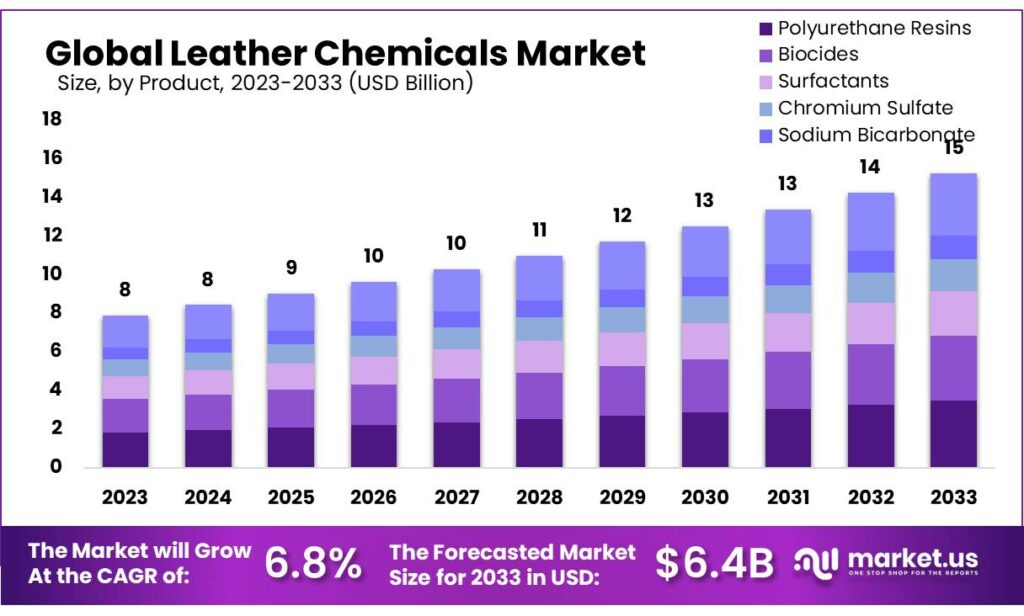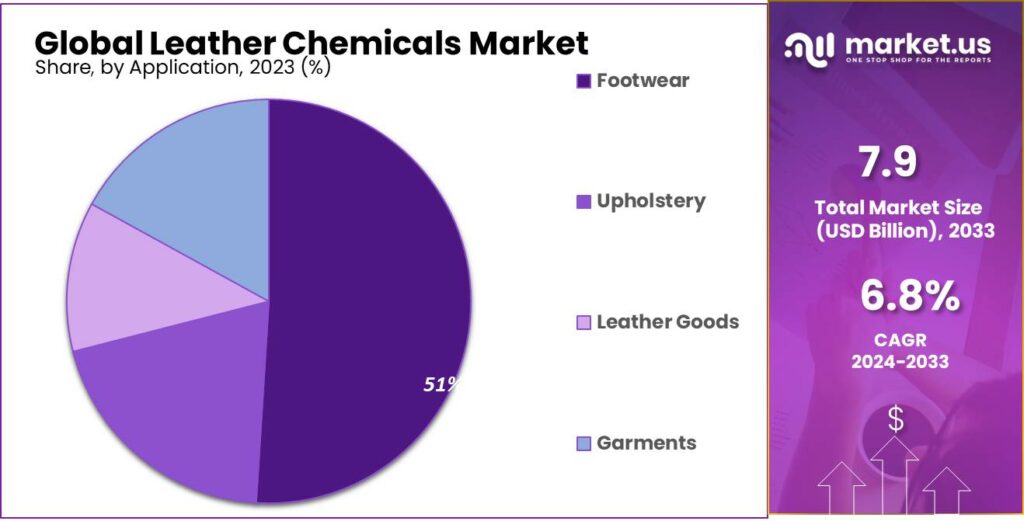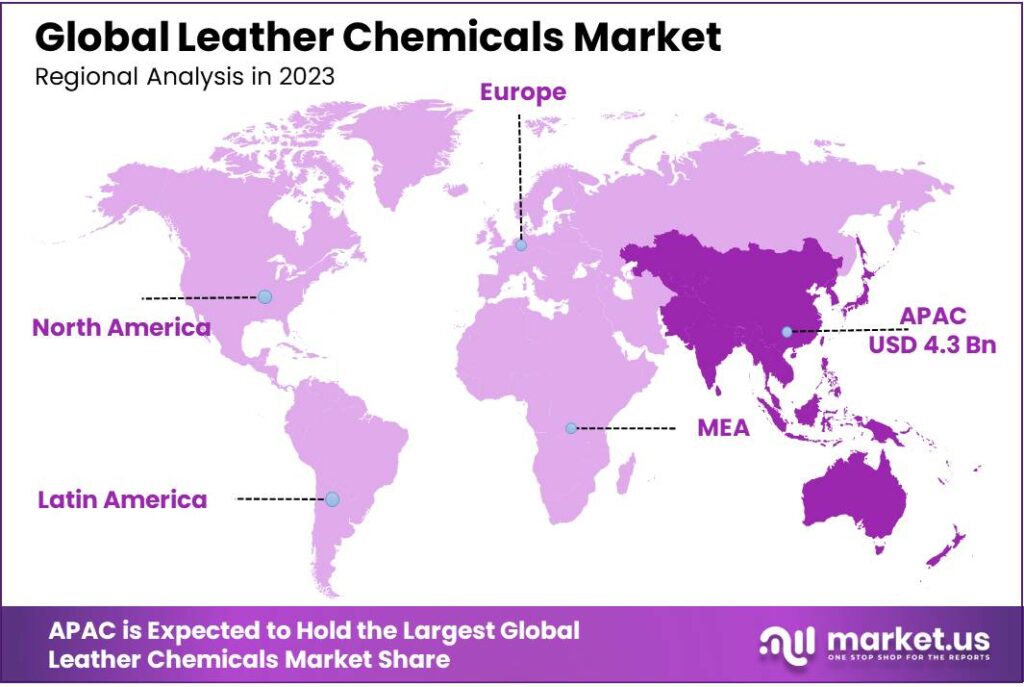New York, Feb. 20, 2024 (GLOBE NEWSWIRE) -- According to Market.us, the Global Leather Chemicals Market size is expected to be worth around USD 15 Billion by 2033, from USD 8 Billion in 2023, and it is poised to reach a registered CAGR of 6.8% from 2024 to 2033.
The Leather Chemicals Market encompasses a specialized segment of the chemical industry dedicated to producing and supplying chemicals used in the various stages of leather processing. Leather chemicals are essential for transforming raw hides and skins into finished leather products that meet specific quality and aesthetic requirements. These chemicals are utilized across multiple phases of leather production, including beamhouse operations (such as soaking, liming, and deliming), tanning, dyeing, and finishing.
Discover key market insights, trends, drivers, and challenges in our sample PDF report: https://market.us/report/leather-chemicals-market/request-sample/

Key Takeaway
- The leather chemicals market is projected to grow from USD 7.9 billion in 2023 to USD 15.2 billion by 2033, with a CAGR of 6.8%.
- Polyurethane resins led the 2023 market, making up 22.9% of revenue, favored for their versatility and environmental benefits.
- The surfactants segment is expected to see a 7.0% growth rate, essential for their role as surface-active agents in leather production.
- Chromium sulfate, valued at USD 818.0 million in 2023, remains vital for tanning and dyeing despite environmental concerns.
- Tanning and dyeing processes dominated the market in 2023, representing over 48.0% of revenue, with beamhouse processes growing at a 6.6% CAGR.
- Footwear was the leading application in 2023, accounting for more than 51% of revenue, driven by high leather demand.
- Upholstery, particularly in automotive and furniture, is projected to grow at a 6.5% CAGR, reflecting its increasing market share.
Factors Affecting the Growth of the Global Leather Chemicals Industry
- Consumer Demand for Leather Products: Increasing consumer appetite for leather goods, including footwear, apparel, and accessories, drives demand for leather chemicals. The quality and finish of leather products are significantly enhanced by advanced chemical treatments, directly influencing consumer satisfaction and demand.
- Technological Advancements: Innovations in chemical processing technologies contribute to more efficient, sustainable, and cost-effective leather production. Advances in tanning agents, dyeing methods, and finishing chemicals enhance the properties of leather, making it more durable, aesthetically pleasing, and environmentally friendly.
- Environmental and Regulatory Pressures: The leather industry faces stringent environmental regulations aimed at reducing pollution and promoting sustainable practices. This has led to a shift towards eco-friendly chemicals and processes, influencing market dynamics and development priorities.
- Global Economic Conditions: The economic health of key market regions affects consumer spending patterns and investment in the leather industry. Economic downturns can reduce demand for luxury leather goods, while economic growth can increase consumer spending and demand for high-quality leather products.
- Availability and Price of Raw Materials: Fluctuations in the availability and prices of raw hides, skins, and chemical raw materials can impact production costs and profitability for leather chemical manufacturers. Price volatility can be caused by factors such as agricultural policies, climate change, and geopolitical events.
Plan your Next Best Move. Purchase the Report for Data-driven Insights: https://market.us/purchase-report/?report_id=28736
Report Segmentation
Product Type Analysis
In 2023, the leather chemicals market saw the polyurethane (PU) resins segment leading with 22.9% of total revenue, primarily due to their increased application in leather processing for their superior tensile strength and elasticity. The shift towards using PU-based synthetic materials and the development of organic solvent-free finishes, particularly hybrid acrylic polyurethane polymers, underscores the demand for more eco-friendly alternatives to traditional materials.
Despite the higher costs associated with their lengthy production process, the environmental benefits of PU resins have positioned them for growth. Surfactants, expected to expand at a 7% growth rate, are becoming increasingly vital for their role as emulsifiers, anti-electrostatic, and water-repellent agents in leather making. Meanwhile, the chromium sulfate segment, essential for tanning and valued at USD 818.0 million in 2021, highlights the continued reliance on chrome salts for leather stabilization despite environmental challenges associated with chromium oxidation.
Process Analysis
In 2023, the tanning and dyeing operations dominated the leather chemicals market, accounting for over 48% of its revenue, driven by essential processes like pickling, degreasing, tanning, and dyeing. These processes are projected to grow at a 6.7% CAGR, with additional steps such as fatliquoring and drying contributing to this growth.
The beamhouse segment, focusing on preparing hides for preservation through wetting, liming, and other processes, is expected to see a 6.6% CAGR. The final stage, finishing, involves various techniques like buffing and spray-coating, using surfactants and polyurethane resins among other components, to meet the rising demand for premium leather products. This demand, coupled with the industry's focus on aesthetics, predicts a continued increase in the need for specialized leather chemicals.
Application Analysis
In 2023, the footwear sector led the leather chemicals market with over 51% of its revenue, fueled by the growing demand for leather in shoe manufacturing. This segment utilizes leather chemicals for various processes including finishing, tanning, and dyeing, enhancing the durability and appearance of the leather used. The upholstery segment is anticipated to follow closely, with a projected CAGR of 6.5%, driven by its extensive use in the automotive and furniture industries for soft leather applications.
This sector relies heavily on leather chemicals for tanning, waterproofing, and other treatments to meet the quality standards of aniline, semi-aniline, and protected leather. Meanwhile, the demand for leather goods like wallets and belts is expected to grow moderately, as these items require less leather but still benefit from the use of dyeing and tanning chemicals, indicating a rising consumer interest in the aesthetic appeal of leather products.

Кеу Маrkеt Ѕеgmеntѕ
Product Type
- Biocides
- Surfactants
- Chromium Sulfate
- Polyurethane Resins
- Sodium Bicarbonate
- Other Product Types
Process Type
- Tanning & Dyeing
- Beamhouse
- Finishing Chemicals
Application
- Footwear
- Upholstery
- Leather Goods
- Garments
Drivers
More and more people are seeking leather goods like stylish bags, shoes, and vehicle interiors. This growing demand acts as a driving force for the leather chemicals market. Additionally, advancements in technology are aiding the refinement of these chemicals, making production quicker and better, thus giving the market an added boost.
Restraints
The prices of raw materials used in making these chemicals can be quite unpredictable, causing instability. There’s also considerable concern about the environmental impact of these chemicals and their production processes. Moreover, changes in fashion trends greatly influence the demand for leather, affecting the market’s stability.
Opportunities
Looking ahead, the rising demand for trendy leather products signals ample room for market expansion. The discovery of more intelligent methods to produce these chemicals might make them more affordable and efficient. Furthermore, the utilization of eco-friendly chemical alternatives presents new growth prospects.
Challenges
The global economic landscape can significantly impact the stability of the leather chemicals market. Additionally, competition from synthetic materials poses a challenge to traditional leather. Moreover, the quest for creating eco-friendly chemicals without compromising quality remains a significant hurdle in this industry’s growth journey.
Have Queries? Speak to an expert or To Download/Request a Sample, Click here.
| Report Attribute | Details |
| Market Value (2023) | US$ 8.0 Billion |
| Market Size (2033) | US$ 15.2 Billion |
| CAGR (from 2024 to 2033) | 6.8% |
| Asia Pacific Region Revenue Share | 50% |
| Historic Period | 2016 to 2023 |
| Base Year | 2023 |
| Forecast Year | 2024 to 2033 |
Regional Analysis
In 2023, the Asia Pacific region led the global market for leather chemicals, capturing over 50% of the revenue share, primarily due to its abundant raw materials and a significant concentration of manufacturers. The region benefits from low labor costs, although Japan presents a unique case with its high imports of luxury goods and a robust automotive industry fueling demand for leather chemicals.
Europe is poised to witness the second-highest growth, with a CAGR of 6.9%, driven by the footwear, automotive, and consumer appliances sectors, alongside Italy's flourishing luxury market and a shift towards vegetable tanning. Concurrently, the expanding Brazilian leather sector, renowned for its shoe and travel accessory production, is set to propel the leather chemicals market in Central and South America, leveraging strong ties to the U.S. market and opening up new avenues for growth.

Кеу Regions and Countries
- North America
- US
- Canada
- Mexico
- Europe
- Germany
- UK
- France
- Italy
- Russia
- Spain
- Rest of Europe
- APAC
- China
- Japan
- South Korea
- India
- Rest of Asia-Pacific
- South America
- Brazil
- Argentina
- Rest of South America
- MEA
- GCC
- South Africa
- Israel
- Rest of MEA
Competitive Landscape Analysis
The competitive landscape of the leather chemicals market is characterized by the presence of several key players operating on a global scale, alongside numerous regional and local manufacturers. This diversity creates a highly competitive environment, with companies vying for market share through innovation, product development, strategic partnerships, and geographic expansion.
Кеу Маrkеt Рlауеrѕ
- Stahl International B.V
- Lanxess AG
- Bayer AG
- Elementis plc
- Texapel
- Chemtan Company Inc.
- Lawrence Industries Limited
- Other Key Players
Recent Developments
- January 2023: LANXESS and TotalEnergies entered into a cooperation on the supply of bio-circular styrene. By partnering with TotalEnergies, the company can offer its customers sustainable solutions and raw materials with a low carbon footprint.
- October 2022: Chem-MAP is pleased to share that Texapel was granted ZDHC Level 3 certification for their leather chemicals, the highest certification offered by the ZDHC Road Map to Zero program.
Explore Extensive Ongoing Coverage on Chemical Research Reports Domain:
- Bauxite market was valued at USD 15.1 billion and is expected to reach USD 19.6 billion in 2032. This market is estimated to register the highest CAGR of 2.7% between 2023 and 2032.
- Microneedling market size is expected to be worth around USD 35.3 billion by 2033, from USD 10.3 billion in 2023, growing at a CAGR of 13.1% during the forecast period from 2023 to 2033.
- Activated alumina market size is expected to be worth around USD 1724 Million by 2033, from USD 1018.9 Million in 2023, growing at a CAGR of 5.4% during the forecast period from 2023 to 2033.
- hydrofluoric acid market size is expected to be worth around USD 6.3 billion by 2033, from USD 3.6 billion in 2023, growing at a CAGR of 5.9% during the forecast period from 2023 to 2033.
- Glycerol market size is expected to be worth around USD 5.9 billion by 2033, from USD 4.9 billion in 2023, growing at a CAGR of 1.9% during the forecast period from 2023 to 2033.
- Insulated Concrete Form Market size is expected to be worth around USD 1380 Million by 2033, from USD 855 Million in 2023, growing at a CAGR of 4.9% during the forecast period from 2023 to 2033.
- Dolomite market size is expected to be worth around USD 4513.7 billion by 2033, from USD 1924.2 Million in 2023, growing at a CAGR of 6.9% during the forecast period from 2023 to 2033.
- Lipid market size is expected to be worth around USD 26.7 billion by 2033, from USD 14.1 billion in 2023, growing at a CAGR of 6.6% during the forecast period from 2023 to 2033.
- Dyes and pigments market size is expected to be worth around USD 68.6 billion by 2033, from USD 41.7 billion in 2023, growing at a CAGR of 5.1% during the forecast period from 2023 to 2033.
- Coated Paper Market size is expected to be worth around USD 34.4 billion by 2033, from USD 22.6 Billion in 2023, growing at a CAGR of 4.3% during the forecast period from 2023 to 2033.
About Us
Market.US (Powered by Prudour Pvt Ltd) specializes in in-depth market research and analysis and has been proving its mettle as a consulting and customized market research company, apart from being a much sought-after syndicated market research report-providing firm. Market.US provides customization to suit any specific or unique requirement and tailor-makes reports as per request. We go beyond boundaries to take analytics, analysis, study, and outlook to newer heights and broader horizons.
Follow Us On LinkedIn Facebook Twitter
Our Blog:
